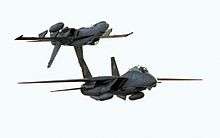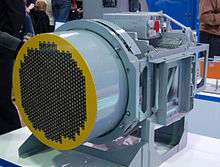Fourth-generation jet fighter
Fourth-generation jet fighter is a general classification of jet fighters in service from approximately 1980 to the present and represent design concepts of the 1970s. Fourth-generation designs are heavily influenced by lessons learned from the previous generation of combat aircraft. Long-range air-to-air missiles, originally thought to make dogfighting obsolete, proved less influential than expected, precipitating a renewed emphasis on maneuverability. Meanwhile, the growing costs of military aircraft in general and the demonstrated success of aircraft such as the F-4 Phantom II gave rise to the popularity of multirole combat aircraft in parallel with the advances marking the so-called fourth generation.
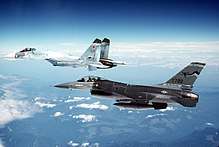
During the period in question, maneuverability was enhanced by relaxed static stability, made possible by introduction of the fly-by-wire (FBW) flight control system (FLCS), which in turn was possible due to advances in digital computers and system-integration techniques. Replacement of analog avionics, required to enable FBW operations, became a fundamental requirement as legacy analog computer systems began to be replaced by digital flight control systems in the latter half of the 1980s.[1]
The further advance of microcomputers in the 1980s and 1990s permitted rapid upgrades to the avionics over the lifetimes of these fighters, incorporating system upgrades such as active electronically scanned array (AESA), digital avionics buses and infra-red search and track (IRST).
Due to the dramatic enhancement of capabilities in these upgraded fighters and in new designs of the 1990s that reflected these new capabilities, the Russian Government has taken to using the designation 4.5 generation to refer to these later designs. This is intended to reflect a class of fighters that are evolutionary upgrades of the 4th generation incorporating integrated avionics suites, advanced weapons efforts to make the (mostly) conventionally designed aircraft nonetheless less easily detectable and trackable as a response to advancing missile and radar technology (see stealth technology).[2][3] Inherent airframe design features exist and include masking of turbine blades and application of advanced sometimes radar-absorbent materials, but not the distinctive low-observable configurations of the latest aircraft, referred to as fifth-generation fighters or aircraft such as the Lockheed-Martin F-22 Raptor.
The United States defines 4.5-generation fighter aircraft as fourth-generation jet fighters that have been upgraded with AESA radar, high-capacity data-link, enhanced avionics, and "the ability to deploy current and reasonably foreseeable advanced armaments".[4][5] Contemporary examples of 4.5-generation fighters are the Sukhoi Su-30SM/Su-34/Su-35,[6][7] the Shenyang J-11D/J-15B/J-16, the Chengdu J-10B/C, the Mikoyan MiG-35, the Eurofighter Typhoon, the Boeing F/A-18E/F Super Hornet, the Lockheed Martin F-16E/F, McDonnell Douglas F-15E, Tejas Mark 1A,[8] JF-17 block III, the Saab JAS 39 Gripen, the Mitsubishi F-2,[9] and the Dassault Rafale.
Design considerations
Performance
General performance has traditionally been the most important class of design characteristics, as it enables a fighter to gain a favorable position to use its weapons while rendering the enemy unable to use theirs. This can occur at long range (beyond visual range or BVR) or short range (within visual range or WVR). At short range, the ideal position is to the rear of the enemy aircraft, where it is unable to aim or fire weapons and the hot exhaust makes a good target for infrared homing missiles. At longer BVR range, the probability of a successful missile intercept is improved by launch at high energy, kinetic (the aircraft's speed towards its target) and potential (altitude advantage). Being able to maneuver violently, and without losing energy meanwhile increases the chance of evading enemy missiles, or escape out of range of the likely return-fire.
These two scenarios have competing demands—interception requires excellent linear speed, while Within Visual Range or WVR engagements require excellent turn rate, while maintaining speed, rapid acceleration, and availability of control at low speeds and high angle of attack.
Prior to the 1970s, a popular view in the defense community was that missiles would render WVR combat obsolete and hence maneuverability useless. Combat experience proved this untrue due to the poor quality of missiles and the recurring need to identify targets visually. Though improvements in missile technology may make that vision a reality, experience has indicated that sensors are not foolproof and that fighters will still need to be able to fight and maneuver at close ranges. So whereas the premier third-generation jet fighters (e.g., the F-4 and MiG-23) were designed as interceptors with only a secondary emphasis on maneuverability, interceptors have been relegated to a secondary role in the fourth generation, with a renewed emphasis on maneuverability. While the trade-offs involved in combat aircraft design are again shifting towards BVR engagement, the management of the advancing environment of numerous information flows in the modern battle-space, and low-observability, arguably at the expense of maneuvering ability in close-combat, the application of thrust vectoring provides a way to maintain it, especially at low speed.
There are two primary contributing factors to maneuverability—the amount of thrust delivered by the engines, and the ability of the aircraft's control surfaces to efficiently generate aerodynamic forces, and hence alterations in the plane's direction. Air combat manoeuvring (ACM) involves a great deal of energy management. The greater energy a fighter has, the more flexibility it has to move where it wants. An aircraft with little energy is immobile, and becomes a defenseless target. Note that available thrust does not necessarily equal speed; while it does give greater acceleration, the maximum speed of an aircraft is also determined by how much drag it produces. Herein lies one important trade-off. Low-drag configurations have small, often highly swept wings that disrupt the airflow as little as possible. However, that also means they have greatly reduced ability to alter the airflow to maneuver the aircraft.
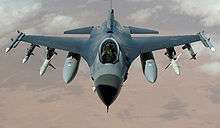
There are two rough indicators of these factors. A plane's turning ability can be roughly measured by its wing loading, defined as the mass of the aircraft divided by the area of its lifting surfaces. A highly loaded wing has little capacity to produce additional lift, and so has limited turning ability, whereas a lightly loaded wing has much greater potential lifting power. A rough measure of acceleration is a plane's thrust-to-weight ratio.
Fly-by-wire
One of the new innovations on fourth generation jet fighters is fly-by-wire, while generation 4.5 introduced Active electronically scanned array radar.
The YF-16, eventually developed into the F-16 Fighting Falcon, was the world's first aircraft intentionally designed to be slightly aerodynamically unstable. This technique, called "relaxed static stability" (RSS), was incorporated to further enhance the aircraft's performance. Most aircraft are designed with positive static stability, which induces an aircraft to return to its original attitude following a disturbance. However, positive static stability, the tendency to remain in its current attitude, opposes the pilot's efforts to maneuver. On the other hand, an aircraft with negative static stability will, in the absence of control input, readily deviate from level and controlled flight.
An aircraft with negative static stability can therefore be made more maneuverable. At supersonic airspeed, a negatively stable aircraft can exhibit positive static stability due to aerodynamic center migration.[1][10] To counter this tendency to depart from controlled flight—and avoid the need for constant minute trimming inputs by the pilot—the 4th gen aircraft has a quadruplex (four-channel) fly-by-wire (FBW) flight control system (FLCS). The flight control computer (FLCC), which is the key component of the FLCS, accepts the pilot's input from the stick and rudder controls, and manipulates the control surfaces in such a way as to produce the desired result without inducing a loss of control. The FLCC also takes thousands of measurements per second of the aircraft's attitude, and automatically makes corrections to counter deviations from the flight path that were not input by the pilot. Coordinated turn is also achieved in the same way, processing thousands of instructions per second to synchronize yawing and rolling to minimize sideslip drag in turns.[11]
Early fourth generation American fighters like the F-15 Eagle and F-14 Tomcat retained electro-mechanical flight hydraulics, while their newer and cheaper alternatives, the F-16 Fighting Falcon and F/A-18 Hornet, incorporated fly-by-wire. The newest derivative of the F-15, the F-15SA Strike Eagle for Saudi Arabia, has fly-by-wire instead of the previous Eagles' hybrid electronic/mechanical system.
Thrust vectoring
Thrust vectoring is a technology to further enhance a fighter's turning ability, first introduced in Soviet fighters. By redirecting the jet exhaust, it is possible to directly translate the engine's power into directional changes more efficiently than via the plane's control surfaces. The Sukhoi Su-27 was the first aircraft to publicly display thrust vectoring for pitch (called 2D TVC), making the aircraft highly maneuverable, capable of near-zero airspeed at high angles of attack without stalling, and dynamic aerobatics at low speeds like Pugachev's Cobra. The three-dimensional TVC nozzles of the Sukhoi Su-30MKI are mounted 32° outward to longitudinal engine axis (i.e. in the horizontal plane) and can be deflected ±15° in the vertical plane. This produces a corkscrew effect, greatly enhancing the turning capability of the aircraft.[12] The MiG-35 with its RD-33OVT engines with the vectored thrust nozzles allows it to be the first twin-engine aircraft with vectoring nozzles that can move in two directions (that is, 3D TVC). Other existing thrust-vectoring aircraft, like the F-22, have nozzles that vector in one direction.[13] The technology has been fitted to the Sukhoi Su-47 Berkut and later derivatives. The U.S. explored fitting the technology to the F-16 and the F-15, but only introduced it on the F-22 Raptor.
Supercruise
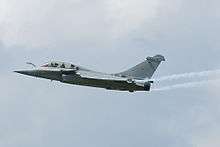
Supercruise is the ability of aircraft to cruise at supersonic speeds without the afterburner.
Because of parasitic drag effects, fighters carrying external weapons stores encounter a vastly increased drag divergence near the speed of sound. This can prevent safe acceleration through the transonic regime or make it too fuel-expensive to be effective on missions. Meanwhile, maintaining supersonic speed without (periodic) afterburner use saves large quantities of fuel too, increasing the range at which an aircraft can in reality still take advantage of its full performance.
According to the German Air Force, the Typhoon can cruise at about Mach 1.2 without afterburner.[15] The manufacturer claims that the maximum level speed possible without reheat is Mach 1.5.[16][17] An EF T1 DA (Development Aircraft trainer version) demonstrated supercruise (1.21 M) with 2 SRAAM, 4 MRAAM and drop tank (plus 1 tonne flight-test equipment, plus 700 kg more weight for the trainer version) during the Singapore evaluation.[18]
Avionics
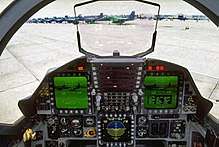
Avionics is a catch-all term for the electronic systems aboard an aircraft, which have been growing in complexity and importance. The main elements of an aircraft's avionics are its communication and navigation systems, sensors (radar and IR), computers and data bus, and user interface. Because they can be readily swapped out as new technologies become available, they are often upgraded over the lifetime of an aircraft. A number of F-15C Eagles, the type was first produced in 1978, have received upgrades in the 2007 such as AESA radar and Joint Helmet Mounted Cueing System and will receive the 2040C Eagle upgrade to keep them in service until 2040, thanks to its large size and long airframe life.
Details about these systems are highly classified. Thus, many export aircraft have downgraded avionics, and buyers often replace them with domestically developed avionics, sometimes considered superior to the original. Examples are the Sukhoi Su-30MKI sold to India, the F-15I and F-16I sold to Israel, and the F-15K sold to South Korea.
The primary sensor for all modern fighters is radar. The U.S. fielded its first modified F-15Cs equipped with AN/APG-63(V)2 Active electronically scanned array radars,[19] which have no moving parts and are capable of projecting a much tighter beam and quicker scans. Later on, it was introduced to the F/A-18E/F Super Hornet and the block 60 (export) F-16 also, and will be used for future American fighters. France introduced its first indigenous AESA radar, the RBE2-AESA built by Thales in February 2012[20] for use on the Rafale. The RBE2-AESA can also be retrofitted on the Mirage 2000. A European consortium GTDAR is developing an AESA Euroradar CAPTOR radar for future use on the Typhoon. Russia has an AESA radar on its MIG-35 and their newest Su-27 versions. For the next-generation F-22 and F-35, the U.S. will use low probability of intercept (LPI) capacity. This will spread the energy of a radar pulse over several frequencies, so as not to trip the radar warning receivers that all aircraft carry.
In response to the increasing American emphasis on radar-evading stealth designs, Russia turned to alternate sensors, with emphasis on infra-red search and track (IRST) sensors, first introduced on the American F-101 Voodoo and F-102 Delta Dagger fighters in the 1960s, for detection and tracking of airborne targets. These measure IR radiation from targets. As a passive sensor, it has limited range, and contains no inherent data about position and direction of targets - these must be inferred from the images captured. To offset this, IRST systems can incorporate a laser rangefinder in order to provide full fire-control solutions for cannon fire or for launching missiles. Using this method, German MiG-29 using helmet-displayed IRST systems were able to acquire a missile lock with greater efficiency than USAF F-16 in wargame exercises. IRST sensors have now become standard on Russian aircraft. With the exception of the F-14D (officially retired as of September 2006), no 4th-generation Western fighters carry built-in IRST sensors for air-to-air detection, though the similar FLIR is often used to acquire ground targets.
However '4.5 generation' fighters started introducing integrated IRST systems, such as the Dassault Rafale boasting the Optronique secteur frontal integrated IRST, a feature adopted very early in its design as an "omnirole" fighter jet. The Eurofighter Typhoon introduced the PIRATE-IRST (beginning with Tranche 1 Block 5 aircraft,[21] while previously build aircraft are being retrofitted since spring 2007[22]) and the F-35s will have built-in, PIRATE-IRST sensors, a feature adopted early in the design, meanwhile beginning in 2012 the Super Hornet will also have an IRST.[23]
The tactical implications of the computing and data bus capabilities of aircraft are hard to determine. A more sophisticated computer bus would allow more flexible uses of the existing avionics. For example, it is speculated that the F-22 is able to jam or damage enemy electronics with a focused application of its radar. A computing feature of significant tactical importance is the datalink. All modern European and American aircraft are capable of sharing targeting data with allied fighters and AWACS planes (see JTIDS). The Russian MiG-31 interceptor also has some datalink capability, so it is reasonable to assume that other Russian planes can also do so. The sharing of targeting and sensor data allows pilots to put radiating, highly visible sensors further from enemy forces, while using that data to vector silent fighters toward the enemy.
Stealth technology
Stealth technology is an extension of the notion of aircraft camouflage to modern radar and infrared detection sensors. While not rendering an aircraft "invisible" as is popularly conceived, stealth makes an aircraft much more difficult to discern among the sky, clouds, or distant aircraft, conferring a significant tactical advantage. While the basic principles of shaping aircraft to avoid detection were known at least since the 1960s, it was not until the availability of supercomputers that shape computations could be performed from every angle, a complex task. The use of computer-aided design, combined with radar-absorbent materials, produced aircraft of drastically reduced radar cross-section (RCS) that were much more difficult to detect on radar. Meanwhile, advances in digital flight control make potentially destabilizing, or control-complicating effects of shape alterations easier to compensate for.
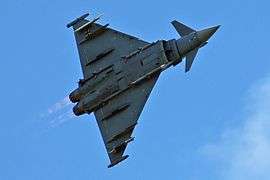
During the 1970s, the rudimentary level of stealth shaping (as seen in the faceted design of the Lockheed F-117 Nighthawk) resulted in too severe a performance penalty to be used on fighters. Faster computers enabled smoother designs such as the B-2 Spirit, and thought was given to applying the basic ideas to decrease, if not drastically reduce, the RCS of fighter aircraft. These techniques are also combined with methods of decreasing the infrared signature, visual signature, and acoustic signature of the aircraft. While fighters designated 4.5 generation under the US-devised system incorporate some low-observable features, so-called fifth-generation fighters have more clearly been designed with this as a very high priority. The inclusion of this as a criterion for the designation of "fifth generation" serves to illustrate the degree to which US manufacturers and their clients appear to assign value to this capability.
There are some reports that the Dassault Rafale's avionics, the Thales Spectra, includes "stealthy" radar jamming and deception technology, and systems for the active cancellation of RADAR analogous to the acoustic noise suppression systems on the Bombardier Dash 8. Conventional jammers make locating an aircraft more difficult, but their operation is itself detectable, with missiles being designed more recently to endeavor to follow the jamming itself. The French system is hypothesized to interfere with detection without revealing that jamming is in operation.
Such a system ought in principle to be able to make an aircraft entirely invisible, were it to be feasible to actively mimic an undisturbed RADAR signature (canceling all reflections, and compensating for any RADAR shadow) however such a system would be incalculably difficult and is not envisaged. Meanwhile, the real effectiveness of systems that allegedly exist is unknown.
Research continues into other ways of decreasing observability by radar. There are claims that Russian researchers are working on "plasma stealth".[24]
There are in any case ways to detect fighters other than radar. For instance, passive infra-red sensors can detect the heat of engines, and even the sound of a sonic boom (which any supersonic aircraft will make) can be tracked with a network of sensors and computers. However, using these to provide precise targeting information for a long-range missile is considerably less straightforward than radar.
IAI Lavi uses an S-duct air intake that prevents radar waves from reflecting off engine compressor fans, thus significantly reducing frontal RCS. This is similar to the layout on the YF-23 stealth fighter.
Combat performance
The F-15 and F-16 have the first and second best known overall combat records of modern jet fighters – an amalgamation of the combat records of both jets in Israeli Air Force service in various conflicts, followed by both jets in USAF service during the Invasion of Iraq in 1991. F-15s have a claimed combat record of 101 victories and zero losses in actual air-to-air combat.[25]
- 1982 Lebanon War: the Israeli Air Force credited its F-15s and F-16s with 86 air-to-air kills, albeit of MiG-21s and MiG-23s, while suffering no air-to-air losses of their own.
- Iran–Iraq War: Iran used F-14s and Iraq deployed MiG-29s, although there are no reports of the two aircraft types actually engaging each other.
- Gulf War
- 1999 Kosovo War
- A Dutch F-16 pilot shot down a Yugoslavian MiG-29A and a USAF F-16 pilot also shot down a MiG-29A.[30][31]
- USAF F-15 pilots shot down four MiG-29s.[30]
- Eritrean-Ethiopian War.
- In February 1999, according to some reports, Ethiopian Su-27 pilots shot down four Eritrean MiG-29s. Some of these sources claim that the Ethiopian planes were flown by Russian pilots, and the Eritrean planes by Ukrainians. (It is certainly true that local pilots were trained by instructors from those nations.[32])
- Soviet–Afghan War.
- Between May 1986 and November 1988, Pakistani F-16s shot down at least eight intruders from Afghanistan. The first three of these were one Su-22, one probable Su-22, and one An-26. The remaining five intruders were(two Su-22s, two MiG-23s, and one Su-25).
Different air forces regularly practice against each other in exercises, and when they fly different aircraft some indication of the relative capabilities of the aircraft can be gained.[33]
During the "Cope India '04" exercise (2004), USAF F-15 Eagles were pitted against Indian Air Force Su-30MKIs, Mirage 2000s, MiG-29s and ageing MiG-21s. The results have been widely publicized with the IAF winning a majority of the mock combat, although the USAF fought at a numerical disadvantage, and both sides without AWACS support thereby restricting BVR combat.[34][35]
The "Cope India 2005" exercise was conducted with teams that used a combination of United States and Russian-designed aircraft. The Christian Science Monitor (CSM) reported that “both the Americans and the Indians won, and lost.”[36] According to the same article the Indian air force designed Cope 2005 in that the rules of engagement be that the forces fight within visual range, and both forces could not take advantage of their long range sensors or weapons.[37]
In July 2007, the Indian Air Force fielded the Sukhoi Su-30MKI during the Indra Dhanush exercise with the Royal Air Force's Eurofighter Typhoon. This was the first time that the two jets had taken part in such an exercise.[38][39] The IAF did not allow their pilots to use the radar of the MKIs during the exercise so as to protect the highly classified N011M Bars.[40] RAF Tornado pilots were candid in their admission of the Su-30 MKI's superior manoeuvring in the air, just as they had anticipated, but the IAF pilots were also impressed by the Typhoon's agility in the air.[41]
Fourth-generation jet fighters compared
| Aircraft | Primary builder |
Number built |
First flight |
Service life |
Length | Wingspan m |
Wing area sq. m |
Empty weight |
Max takeoff weight |
Max Speed km/h |
Range km |
Ceiling m |
Engines × Thrust |
|---|---|---|---|---|---|---|---|---|---|---|---|---|---|
| Tornado ADV | 218 | 1979 | 1985–2011 | 18.68 | 13.91/8.60 | 26.60 | 14,500 kg | 27,986 kg | 2,337 | 4,265 | 15,240 | 2 × 40.5 kN/73.5 kN | |
| Typhoon | 570[42] | 1994 | 2003–Present | 15.96 | 10.95 | 51.20 | 11,000 kg | 23,500 kg | 2,495[43] | 3,790 | 19,812 | 2 × 60 kN/90 kN | |
| Mirage 2000 | 601 | 1978 | 1982–Present | 14.36 | 9.13 | 41.00 | 7,500 kg | 17,000 kg | 1,960 | 1,600 | 15,200 | 1 × 54.3 kN/86.1 kN | |
| Rafale | 175[44][45] | 1986 | 2001–Present | 15.27 | 10.80 | 45.70 | 10,196 kg | 24,500 kg | 1,912 | 3,700 | 15,240 | 2 × 50.04 kN/75.62 kN | |
| HAL Tejas mk 1 | 40[46] | 2001 | 2015–present | 13.20 | 8.20 | 38.40 | 6,560 kg | 13,500 kg | 2,226 | 3,200 | 16,500 | 1 × 53.9 kN/89.8 kN | |
| F-2 | 98 | 1995 | 2000–Present | 15.52 | 11.13 | 34.84 | 9,527 kg | 22,090 kg | 2,124 | 4,000 | 18,000 | 1 × 76 kN/125 kN | |
| FA-50 | 78 | 2002 | 2005–Present | 13.14 | 9.45 | 23.69 | 6,470 kg | 12,300 kg | 1,640 | 1,851 | 14,630 | 1 × 53.07 kN/78.7 kN | |
| CAC/PAC JF-17 Thunder|JF-17 block 2 | 140+ | 2003 | 2007–Present | 14.93 | 9.48 | 24.43 | 6,600 kg | 12,700 kg | 2,230 | 3500 | 16,920 | 1 × 53.4 kN/86.5 kN | |
| JH-7 | 240 | 1988 | 1992–present | 22.32 | 12.80 | 42.20 | 14,500 kg | 28,475 kg | 1,808 | 3,700 | 16,000 | 2 × 54.29 kN/91.26 kN | |
| J-11/J-15/J-16 | 253+ | 1998 | 1998–Present | 21.90 | 14.70 | 62.04 | 16,380 kg | 33,000 kg | 2,496 | 3,530 | 19,000 | 2 × 75.22 kN/132.0 kN | |
| J-10 | 400+ | 1998 | 2005–Present | 15.49 | 9.75 | 33.10 | 9,750 kg | 19,277 kg | 2,336 | 3,200 | 18,000 | 1 × 89.17 kN/130.0 kN | |
| L-15B | 100+ | 2006 | 2013–Present | 12.27 | 9.48 | 24.00 | 6,000 kg | 11,500 kg | 1,700 | 3,100 | 16,500 | 2 × 24.7 kN/41.2 kN | |
| F-CK-1 Ching-kuo | 130 | 1989 | 1994–Present | 14.21 | 9.46 | 24.20 | 6,500 kg | 12,000 kg | 1,911 | 1,100 | 16,800 | 2 × 27.0 kN/42.0 kN | |
| MiG-29/35 | 1,600 | 1977 | 1983–Present | 17.37 | 11.40 | 38.00 | 11,000 kg | 20,000 kg | 2,400 | 2,100 | 18,013 | 2 × 50.0 kN/81.3 kN | |
| MiG-31 | 500 | 1975 | 1981–Present | 22.69 | 13.46 | 61.60 | 21,820 kg | 46,200 kg | 3,005 | 3,300 | 20,600 | 2 × 93.0 kN/152.0 kN | |
| Su-27/30/33/35 | 1,457+[S 1] | 1977 | 1985–Present | 21.90 | 14.70 | 62.00 | 16,380 kg | 30,450 kg | 2,496 | 3,900+ | 19,000 | 2 × 75.22 kN/122.6 kN | |
| Yak-130 | 140+ | 1996 | 2010–Present | 11.49 | 9.84 | 23.52 | 4,600 kg | 10,290 kg | 1,060 | 2,100 | 19,000 | 2 × 24.52 kN | |
| JAS 39 Gripen | 271[53] | 1988 | 1997–Present | 14.10 | 8.40 | 30.00 | 6,800 kg | 14,000 kg | 2,204 | 3,200 | 12,500 | 1 × 54.0 kN/80.5 kN | |
| Sea Harrier FA.2 | 29 | 1993 | 1993–2016 | 14.20 | 7.60 | 18.68 | 6,374 kg | 11,900 kg | 1,182 | 3,600 | 16,000 | 1 × 95.64 kN/80.5 kN | |
| Hawk 200 | 62 | 1986 | 1993–Present | 11.38 | 9.39 | 16.69 | 4,128 kg | 9,101 kg | 1,037 | 1,950 | 15,250 | 1 × 26 kN | |
| F-14 Tomcat | 712 | 1970 | 1974–Present | 19.10 | 19.55/11.58 | 54.50 | 19,838 kg | 33,730 kg | 2,485 | 2,960 | 15,200 | 2 × 64.4 kN/123.7 kN | |
| F-15 Eagle | 1,198 | 1972 | 1976–Present | 19.43 | 13.05 | 56.50 | 12,700 kg | 30,845 kg | 2,656 | 5,550 | 20,000 | 2 × 64.9 kN/105.7 kN | |
| F-15E Strike Eagle | 513[N 1] | 1986 | 1988–Present | 19.43 | 13.05 | 56.50 | 14,300 kg | 36,700 kg | 2,665 | 3,900 | 18,200 | 2 × 79 kN/129.7 kN | |
| F-16 Fighting Falcon | 4,604[56] | 1974 | 1978–Present | 15.06 | 9.96 | 27.87 | 8,570 kg | 19,200 kg | 2,120 | 4,220 | 15,240 | 1 × 76.3 kN/127.0 kN | |
| F/A-18 Hornet | 1,480 | 1974 | 1983–Present | 17.10 | 12.30 | 38.00 | 10,400 kg | 23,500 kg | 1,915 | 3,330 | 15,240 | 2 × 48.9 kN/79.2 kN | |
| F/A-18E/F Super Hornet | 608[57] | 1995 | 1999–Present | 18.31 | 13.62 | 46.5 | 14,552 kg | 29,937 kg | 1,915 | 3,330 | 15,000 | 2 × 62.3 kN/97.9 kN | |
In development
Cancelled
See also
References
- Hoh, Roger H. and David G. Mitchell. "Flying Qualities of Relaxed Static Stability Aircraft - Volume I: Flying Qualities Airworthiness Assessment and Flight Testing of Augmented Aircraft." Federal Aviation Administration (DOT/FAA/CT-82/130-I), September 1983. pp. 11ff.
- Fulghum, David A. and Douglas Barrie "F-22 Tops Japan's Military Wish List". Aviation Week and Space Technology, 22 April 2007. Retrieved: 3 October 2010.
- "The Gray Threat" Archived 2007-08-19 at the Wayback Machine. Air Force Magazine.
- "CRS RL33543: Tactical Aircraft Modernization" Archived 2009-08-30 at the Wayback Machine. Issues for Congress 9 July 2009. Retrieved: 3 October 2010.
- "National Defense Authorization Act for Fiscal Year 2010 (Enrolled as Agreed to or Passed by Both House and Senate)". thomas.loc.gov. Retrieved: 3 October 2010.
- https://thediplomat.com/2018/02/russia-to-upgrade-su-30sm-fighter-jets-in-2018/
- https://www.rt.com/news/sukhoi-su-34-test-861/
- https://www.indiatoday.in/magazine/up-front/story/20190121-a-liability-called-rafale-point-of-view-1428691-2019-01-11
- https://thediplomat.com/2015/06/is-japan-facing-a-shortage-of-fighter-aircraft/
- Aronstein and Piccirillo 1996, p. 21.
- Greenwood, Cynthia. "Air Force Looks at the Benefits of Using CPCs on F-16 Black Boxes." Archived 2008-10-11 at the Wayback Machine CorrDefense, Spring 2007. Retrieved: 16 June 2008.
- "Air-Attack.com – Su-30MK AL-31FP engines two-dimensional thrust vectoring" Archived 2010-09-17 at the Wayback Machine. air-attack.com. Retrieved: 3 October 2010.
- "MiG-35". domain-b.com. Retrieved: 3 October 2010.
- "Fox Three". Archived May 25, 2013, at the Wayback Machine dassault-aviation.com. Retrieved: 24 April 2010.
- "Supercuise at about Mach 1.2". luftwaffe.de. Retrieved: 3 October 2010.
- "Supercruise at about Mach 1.2". eurofighter.at. Retrieved: 3 October 2010.
- "Eurofighter capability, p. 53. Supercruise 2 SRAAM 6 MRAAM" Archived 2009-03-27 at the Wayback Machine. mil.no/multimedia/archive. Retrieved: 24 April 2010.
- AFM September 2004 "Eastern smile" pp. 41–43.
- "U.S. Fighters Mature With AESA Radars." Archived 2012-05-09 at the Wayback Machine defense-update.com. Retrieved: 3 October 2010.
- "Le radar RBE2, l'arme fatale du Rafale à l'export". latribune.fr.
- "Eurofighter Typhoon." publicservice.co. Retrieved: 3 October 2010.
- "Type Acceptance for Block 5 Standard Eurofighter Typhoon." Archived 2007-09-27 at the Wayback Machine www.eurofighter.com, Eurofighter GmbH, 15 February 2007. Retrieved: 20 June 2007.
- Warwick, Graham. "Ultra Hornet." flightglobal.com, 13 March 2007. Retrieved: 3 October 2010.
- http://www.aeronautics.ru/archive/research_literature/aviation_articles/Aviation%20Week/topics/plasma_stealth/index.htm Archived 2006-09-25 at the Wayback Machine "Research Articles." Venik's Aviation Data Archive. Retrieved: 3 October 2010.
- "F-15K - Republic of Korea." Boeing.com. Retrieved: 3 October 2010.
- "Intelligence Community Assessment of the Lieutenant Commander Speicher Case." Archived 2007-10-01 at the Wayback Machine foia.cia.gov. Retrieved: 3 October 2010.
- "Operation Desert Storm Downed Pilot." Central Intelligence Agency, USA.
- "Iraqi Air-to-Air Victories since 1967." ACIG. Retrieved: 3 October 2010.
- Sci Archived 2006-09-25 at the Wayback Machine Retrieved: 3 October 2010.
- "F-16 Timeline 1999." f-16.net. Retrieved: 3 October 2010.
- "Zap 16." Archived 2006-06-23 at the Wayback Machine zap.16.com. Retrieved: 3 October 2010.
- Tom Cooper; Jonathan Kyzer; Nadew Mladenov; Alexander Mladenov (September 2, 2003). "II Ethiopian Eritrean War, 1998 - 2000". ACIG. Archived from the original on 2010-02-01. Retrieved 2010-02-01.
- Cox, Jody D. and Hugh G. Severs. "The Relationship Between Realism in Air Force Exercises and Combat Readiness." Air Forces Issues Team, Washington DC, September 1994, pp. 1–114.
- "Russian fighters superior, says Pentagon." Archived 2005-03-13 at the Wayback Machine newsfromrussia.com. Retrieved: 3 October 2010.
- "Su-30MK Beats F-15C 'Every Time'." Aviation Week and Space Technology copy on archive.org
- Baldauf, Scott. "Indian Air Force, in war games, gives US a run." csmonitor.com. Retrieved: 3 October 2010.
- "Fishbed vs Falcon: Why the ancient MiG-21's F-16 kill is no fluke". www.businesstoday.in. Retrieved 2020-04-04.
- "Exercise Indra Dhanush wraps up at Waddington". mod.uk. Archived from the original on 2010-04-11. Retrieved 2009-12-23.
- "Exercise Indra Dhanush 07, RAF Waddington." targeta.cp.uk. Retrieved: 3 October 2010.
- "India's Sukhois turn it on in UK skies, turn off radars". Archived from the original on 2009-09-06. Retrieved 2009-12-23.
- Parsons, Gary. "Waddington's Indian Summer: Part three: the Exercise". Air-scene UK. Archived from the original on 2011-08-04. Retrieved 2011-09-16.
- https://www.airbus.com/defence/eurofighter.html
- 3, BMLVS - Abteilung Kommunikation - Referat. "Bundesheer - Waffen und Gerät - Eurofighter EF 2000". www.bundesheer.at.CS1 maint: numeric names: authors list (link)
- "Dans l'usine du Rafale, un avion " made in France "". 31 March 2016 – via www.la-croix.com.
- http://www.dassault-aviation.com/wp-content/blogs.dir/2/files/2017/03/conf-de-presse-8-mars-v060317-EN.pdf
- Gady, Franz-Stefan (March 27, 2019). "India's HAL Rolls Out 16th Tejas Light Combat Aircraft". The Diplomat. Retrieved 2020-02-05.
- "JF-17 Block-2 and Block-3 Details Confirmed". Quwa. 2015-10-17. Retrieved 2019-07-04.
- Russia Air Force Handbook (World Strategic and Business Information Library), International Business Publications USA (1/1/2009), P. 167
- https://www.rbth.com/science-and-tech/332129-what-military-equipment-russia-sold-lately
- https://nationalinterest.org/blog/buzz/russias-su-33-fast-and-capable-just-too-big-136452
- Russia: 88
- China: 24
- https://saab.com/gripen/our-fighters/users/
- Davies 2002, p. 90.
- https://www.arabianaerospace.aero/saudi-f-15-fleet-to-be-armed-with-slam-er.html
- https://news.lockheedmartin.com/2018-06-25-Lockheed-Martin-Awarded-Contract-to-Build-F-16-Block-70-Aircraft-for-Bahrain
- https://www.navy.mil/submit/display.asp?story_id=112750
Bibliography
- Aronstein, David C. and Albert C. Piccirillo. The Lightweight Fighter Program: A Successful Approach to Fighter Technology Transition. Reston, VA: AIAA, 1996
- Kelly, Orr. Hornet: The Inside story of the F/A-18. Novato, California: Presidio Press, 1990. ISBN 0-89141-344-8.
- Kopp, Carlo. "Lockheed-Martin F-35 Joint Strike Fighter Analysis 2002." Air Power Australia, 2002. Retrieved: 10 April 2006.
- Richardson, Doug. Stealth Warplanes: Deception, Evasion and Concealment in the Air. London: Salamander. 1989, First Edition. ISBN 0-7603-1051-3.
- Shaw, Robert. Fighter Combat: Tactics and Maneuvering. Annapolis, Maryland: Naval Institute Press, 1985. ISBN 0-87021-059-9.
- Sweetman, Bill. "Fighter Tactics." Jane's International Defense Review. Retrieved: 10 April 2006.

